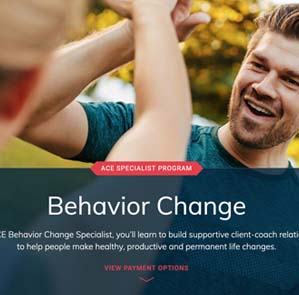
Katie has hired you as her health coach, and she has chosen nutrition and weight loss as her primary areas on which to work. You guided her in setting up her week one goals, which she seemingly met with ease. Now she’s been working with you for six weeks, and she has yet to meet the goals she set during week two. She comes up with varying excuses for why she can’t meet the goals, despite the two of you brainstorming possible solutions to her potential obstacles. Your first thought is that she’s self-sabotaging her efforts and not even trying to succeed. But is she really?
This is Your Brain on Fear
Before we delve into whether Katie is being a so-called resistant client, let’s consider what the brain does when it’s faced with a potential threat. This is important, because we need to understand what the brain considers a threat.
You’re likely familiar with the body's fight-or-flight response. When faced with a threat—real or imagined, physical or emotional—the most primitive parts of the brain go into action to determine if the threat is a credible one. If it finds that yes, the threat is real, it will then go into survival mode and determine if you should stay and fight or run away—whichever one will most likely result in survival.
The fight-or-flight response is important in the case of true physical threats. For instance, if you’re out for a run and a vicious dog comes racing out at you, or if a shooter were to enter your building, these are real, physical threats to your safety. In either case, the brain will immediately determine if you should fight back or flee.
The problem with the primitive parts of your brain determining what is or is not a threat, however, is that they do not differentiate between real and imagined or physical and emotional threats. This can create on-going anxiety and stress when our brains are continually interpreting potential threats to our well-being. In response to these threats, our brains also devise tactics to keep us safe from this potential harm.
As an example, let’s say you had your heart broken at some point in your life. Risking another broken heart is considered a threat to your brain, because it does not want to experience that emotional pain again. Consequently, with subsequent relationships, you’ve guarded your heart as a way of not having to experience that pain again. You might even go so far as to purposely sabotage relationships if you feel they’re becoming too emotionally intimate. This sabotage might be in the form of you suddenly becoming less responsible and doing things like showing up late (or not at all). Maybe you stop communicating as well as you had previously. Or perhaps you go so far as to cheat on your partner.
Over time these tactics become imprinted on your brain. They become your brain’s go-to fix when it feels threatened. This then becomes your pattern. You don’t have to think about these tactics. They just become part of your comfort zone and your automatic response to feeling unsafe or uncomfortable.
These types of tactics are referred to as familiarity heuristic. In other words, your brain reverts to what it’s familiar with when faced with a threat. Remember, your brain’s job is to keep you safe and make sure you survive. What the brain considers safe is what is familiar. After all, what you’ve done to this point has kept you alive. You’ve survived so far, so as far as your brain is concerned, what it’s done to date to keep you safe has worked.
Unfortunately, what keeps us safe is also what often keeps us stuck.
“The brain seeks out evidence to stabilize the current situation,” explains Karen Delano, a certified transformational life coach from Foxboro, Mass. “What we learned that we needed to survive becomes necessary for continued survival. This is often learned at a very young age.”
Delano goes on to say that we attach meaning to experiences. “Whatever experience we’ve had in the past, we made it mean something. And then we formed a belief based on that experience. Over time, this belief is confirmed and imprinted on our brains, as our experiences reinforce this belief.”
In other words, the brain simply reverts back to what it knows—what it believes and what is comfortable and familiar. Let’s consider Katie again.
What we haven’t said yet is that Katie has had past experiences with weight loss, in which she was successful with losing the weight. However, she has always regained the weight, resulting in Katie feeling like a failure. So, while she wants to lose the weight, she is engaging in behavior that is keeping her safe, because if she is successful at losing the weight again, she fears she will just gain it back. This, in turn, would perpetuate her feelings of failure—and embarrassment and shame—because she believes she can’t keep the weight off, based on her past experiences with weight loss. This is simply her brain attempting to keep her safe and avoid these feelings of failure. It’s as if her brain is saying, “Sure, Katie, you could lose the weight. You’ve done it before. But why risk it? You’ll just gain it all back and then you’ll look foolish and lazy. If you don’t even try to lose it, you won’t have to take that risk.”
So, Is There Really Such a Thing as Self-sabotage?
When you begin to see “excuses” for what they really are—your brain simply trying to keep you safe, and in the process of doing so, reverting to what it knows—it can put a different spin on what we refer to as resistant or self-sabotaging clients.
“I think of ‘excuses’ as ineffective habits revealed or negative beliefs in disguise, both of which can effectively be reprogrammed,” says Amy McCann, a certified high-performance coach who specializes in stress management, and author of Persevere to Succeed: A Practical Guide to Ignite the Fire of Success Through Uncertainty. “This keeps me engaged in the process at hand, which is to help the client progress. This way of thinking steers me out of any potential judgment I might make about a client and into the practice of serving my client well.”
McCann highlights the importance of tapping into your clients’ “why.” “When it comes to our brains,” she explains, “we can learn to engage more fully in habits that match our personal definition of a more meaningful life. In this way, it becomes less about following what our brains tell us to do and more about what is necessary to engage with today, to become who we imagine ourselves to be.”
Delano adds that it’s important to consider that whatever tactics your client is currently engaging in may simply be protective responses to past experiences. And in that way, these client tactics have positive intentions—to keep them safe. “I’ve found it helpful to show appreciation for the positive intention of the present state before we try to revise it,” she confirms. “At some point, it was a solution for some issue or problem.”
This means going a bit deeper to get to the root of the current behavior. “If we just talk about action steps without addressing the feelings, stories and meanings, I think we miss out on the best way to help our clients,” argues Delano. “When we go even deeper into beliefs and identity, that’s where true transformation can happen. We also need to help the client focus on finding new evidence to support the experience they want to be having.” This can be accomplished by using cognitive restructuring tools, including those found in this CERTIFIED article on cognitive behavioral coaching techniques.
Both McCann and Delano feel that the terms “self-sabotaging” and “resistant client” need to be deleted from our coaching vocabulary.
“I believe it isn’t my job to assess or analyze whether or not a client is engaging in self-sabotaging choices,” says McCann. “I believe it’s more important for all coaches to develop trust and enthusiasm in the coaching process. Our service as coaches is to affirm our clients’ progress and challenge them in ways that support, not analyze. In the end, mutual trust is gained, frustration is alleviated and progress is gained beyond coaching sessions.”
Delano agrees. “The terms ‘self-sabotage’ and ‘resistant’ make it seem like the client is willfully not complying, which just isn’t true,” says Delano. It may actually be a positive intention or protective mechanism at play, she explains “even if it’s no longer serving them.”
Rather than saying you have a resistant client, Delano suggests thinking of your client as simply working with yesterday’s solution, which implies that they are capable of taking care of themselves.
“When we can see our clients through a different, more positive lens, they see themselves through a different lens,” Delano says. “We focus on what’s getting in their way and how we can help, rather than judge them. This influences our approach and ultimately their experience. It’s the difference between our clients feeling frustration, guilt and shame or feeling strengthened and supported.”
When Thoughts Get in the Way of Progress
Chris Gagliardi, ACE Scientific Education Content Manager and ACE Certified Health Coach, offers his thoughts on self-sabotage and resistance. “Rather than thinking of the client as being resistant to change or self-sabotaging,” says Gagliardi, “it may be more appropriate to consider that they may be struggling with thoughts that don’t align with the goals at hand and are ultimately counterproductive to the current situation.” In other words, it is our thoughts that may unintentionally get in the way of the progress we are trying to make.
He offers this example as an illustration: “Imagine you have a client who, during the winter months, has set a goal to wake up 30 minutes earlier on weekdays to go on a walk before breakfast. While the client may have every intention of achieving this goal, each morning a private dialog is taking place in their mind once the alarm goes off. One voice is arguing for change and making the case to get out of bed, while another is trying to keep them safe by suggesting they stay warm in bed and not go out into the cold for a walk. This internal conflict can present itself in every situation in that there may be voice of resistance inside that encourages a person to be safe and content, even if that means abandoning their goals.
So, what can you do about this with your clients? As coaches, explains Gagliardi, we can change our perspective from one of judgement to one of unconditional positive regard, which can, in turn, help clients to view themselves differently. For example, rather than seeing themselves as someone who gets in their own way, they can start believing that they are resourceful and capable of change.
According to Gagliardi, one way to help clients shift their mindset is through acknowledgement and awareness. “Work with clients to help them to understand that these protective thoughts and responses take place and help them to become aware of when these protective, but often unproductive, thought may be creeping in. As the client increases their awareness they will begin to recognize when these thoughts appear and that is a great first step,” he explains.
The next step is to help the client move beyond identifying the counterproductive thoughts to “catching” them or pausing them. “Thinking about our earlier example,” says Gagliardi, “imagine your client is lying in bed on that cold winter morning and the alarm goes off. Here comes the internal chatter and voice arguing for change and the one arguing for safe, warm and cozy. Your client is now aware of these thoughts and have paused the conversation.” That’s a great first step, but what can they do next? One strategy Gagliardi uses with his clients is to urge them to acknowledge that this is occurring and that both voices want what is best for them, thank the voice that wants them to stay safe and cozy in bed, and then say “not today.”
Of course, this is just one example of how those negative thoughts can be put on hold. You and your clients can figure out together the most effective ways that help them close this loop of thinking. The point is to have some way to interrupt and disrupt the inner dialogue and move in the direction they have set for themselves.
Expand Your Knowledge
ACE Behavior Change Specialist Program
Any fitness, healthcare or allied health professional who wants to effectively guide their clients to their goals will benefit from this specialization. You will gain crucial communication skills to foster effective client-coach relationships and will learn cognitive behavioral coaching to help your clients reach their potential. After finishing the program, you will own critical skills that will elevate your profile as a health or exercise professional.
Coaching Client With Chronic Pain: Relief From the Inside Out
More than 25 million Americans suffer from daily chronic pain, which significantly impacts their physical and mental well-being. Understanding your clients’ pain from their psychological and emotional viewpoint can help you make great progress in mitigating it. In this course, you’ll learn how to recognize, anticipate and meet or exceed the deepest psychological and social needs of your clients. This approach will help you learn to work more effectively with clients who suffer from chronic pain and help them ease the discomfort that they live with every day.
Creating a Motivational Climate for Behavior Change
How do you create an environment where motivation flourishes? When clients perceive their physical-activity settings and those leading them as caring and task-involving, they are more likely to have positive experiences, which leads to increased engagement, participation and adherence. In this course you will learn specific strategies for creating the best motivational environment for clients to be successful and achieve their behavior change goals. Using the ACE Mover Method and ACE ABC Approach, you will be equipped to immediately foster a positive motivational climate in your fitness business to help get and keep clients moving.





 by
by 





